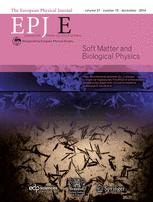May 25 2016
As the technology downsizes, the microscopic-scale jungles are usually operated by scientists and where novel approaches are developed by current explorers to transport tiny objects of varied sizes throughout a heterogeneous environment, without losing them.
 © Springer, Part of Springer Science
© Springer, Part of Springer Science
Researchers, Pietro Tierno and Arthur Straube, from the University of Barcelona, Spain, have discovered a new method, which through a magnetic field change, can be used to selectively control the disaggregation or aggregation of two different sizes of magnetically interacting particles in a liquid suspension. Studies performed in the past focused only on one-sized particles. The results of the study published in EPJ E indicate that long chains of huge particles in liquid suspension can be constructed, creating channels that force the microscopic particles to move along.
This may be helpful, for instance, when categorizing magnetic beads according to size, transporting biological species to test them, or dividing chemical or biological bodies in lab-on-a-chip devices. It is particularly appealing to use a magnetic field to control the transport of microscopic bodies. The reason is based on the fact that properties of object and fluid stay unchanged, unlike when electric field micro manipulation or optical tweezers are applied.
They are based on a magnetic film composed of ferrite garnet, which was first developed in the 1980s for use in magnetic data storage devices, and can produce a strong, irregular magnetic field above its surface.
By examining particles of two diverse sizes, the paper’s authors discovered that, relying on their altitude above the magnetic substrate’s surface, the particles are exposed to varied magnetic forces, resulting in varying levels of mobility. This occurrence develops from an alteration in the equilibrium of magnetic forces inflicted on the particles and their separate coupling with the moving landscape. By altering the external field, the authors could selectively manipulate the aggregation or disaggregation based on the particle size. Supplementary simulations verify the effectiveness of their theory, as they match well with the experiments.
This article is part of the EPJE Topical Collection ”Nonequilibrium Collective Dynamics in Condensed and Biological Matter” edited by Holger Stark, Markus Baer, Carsten Beta, Sabine Klapp and Andreas Knorr.
Source: http://www.springer.com